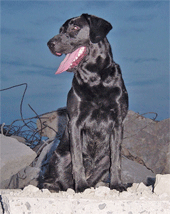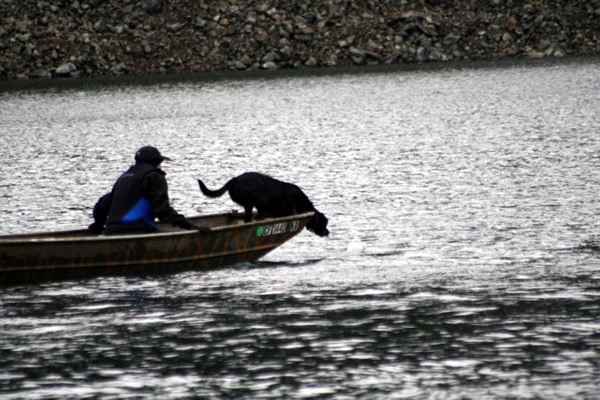If you want to review specific lessons, go to: Search and Rescue K9 Introduction Home Page
Your progress:
Imagine This ...
Late fall in the mountains.
After a long day of exploring the scenery around their campsite, the Bulger family makes their way back to camp at around dusk to start a fire and prepare dinner. In their haste to get back before dark, they realize that their 6-year-old son Timmy didn't follow them back to their camp.
Frantically, they call for him while racing back up the path where they thought they last saw him. Nothing. Darkness, freezing temperatures and woodland creatures are emerging ... and Little Timmy is nowhere to be found.
They race down the mountain to call 911, who in turn dispatch the local Search and Rescue (SAR) Team.
The SAR Team arrives with lots of resources, including some search and rescue dogs, who were immediately sent out into strategically assigned areas.
At around midnight, the Bulger family hears in the distance the sound of a SAR dog barking ... and then radio traffic that confirms that Little Timmy has been found safe and is being brought back to camp by the SAR K9 handler and their Team.
A group effort to be sure that was made easier because of a reliable and focused search dog named "Boomer".
In search and rescue, there are three (3) primary types of SEARCH resources.
- 1Physical Searchers
- 2Technical Searchers
- 3K9 Searchers
The Search and Rescue K9 (SAR K9) is one of the most well-known resources used in Search and Rescue (SAR) operations like the one that would ensue in the search for Little Timmy.
The other two search resources are Physical Searchers and Technical Searchers. These are explored and explained in-depth in the engaging and informative course entitled Search and Rescue Fundamentals.
In K9 Search and Rescue, even the K9 Search Team consists of:
The human component of the team is the handler and while their contribution to the search effort is massive, their primary responsibility on a search is to "put their dog's nose where it has the best chance of detecting the scent of the missing person."
Simply put, handlers are the transportation for the SAR K9 to and from a search operation.
This course will focus primarily on the ...
... K9 SEARCHER

K9 Maggie
- A well-trained search and rescue K9 (SAR K9) can serve a vital and time-saving role in a missing person incident.
- Where humans use their eyes and ears to detect items, K9’s use their powerful nose, which is 60-100 times more effective in detecting scent than a human's nose.
- Not only that, they are able to discriminate or distinguish between multiple odors, like the paprika in a pot of stew versus humans who mainly smell the one or two most dominant odors.

K9 searching from a boat
This ability to discriminate is extremely valuable when looking for a lost or missing person in an area contaminated by other odors.
Humans also present a unique scent picture.
- To discriminate among all of the other odors in their environment SAR K9's rely on the millions of skin cells that slough off the human body every day that are made up of microscopic tissue.
- As we sit, walk or run, each of these skin particles that naturally sloughs off of our bodies becomes airborne and are transported by the wind and other environmental conditions (sun, water, heat, shade).
- Think of the Peanuts character Pig Pen on the Snoopy Cartoon.
This creates an abundance of scent clues with which the well-trained SAR K9 can detect and eventually locate a lost, missing or trapped person.
- The ability for a dog to use its nose to detect a trained odor is called olfaction, or sense of smell.
Current research suggests that dogs are also able to detect components of a respiration (our breath) in order to identify us.
SAR K9 Example
Here's an example of a SAR dog named Stetson at work using these scent clues in a training video taken from the dog's perspective.
There IS a lively soundtrack to this video and it IS safe for all audiences. Volume controls are on the bottom right of the video.
Thanks to A. Olvera and K9 Stetson from one of the 28 FEMA Urban Search & Rescue Task Forces for sharing this incredible video!
If there were only human searchers looking for that "victim", how long would have taken to find him?
